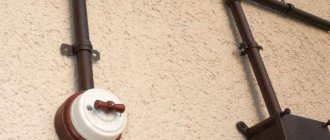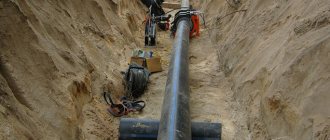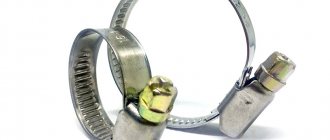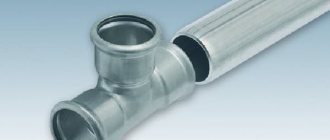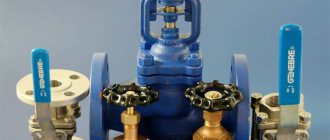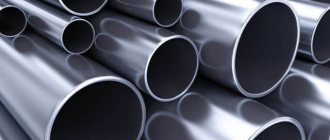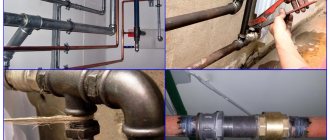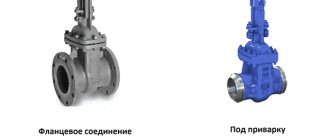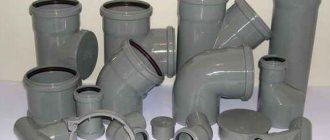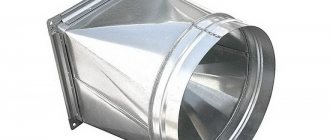Fastening by installing a clamp is one of the most accessible and inexpensive ways of fixing a pipe to a structure or support. With their help, it is easiest to achieve a strong and reliable fixation of the pipeline. To choose the right device, you need to know what options the market offers. Do you agree?
We will tell you what you should pay attention to when choosing pipe clamps. The article we presented describes in detail how to choose the best option and how to install it. The technology is described in detail and recommendations are given, adherence to which will ensure an ideal result.
What is the difference between fastening models and repair models?
Clamps manufactured by our industry are classified according to their purpose as fastening and repair, and the name itself defines their purpose, which is their main difference. Fastening models are designed to fix pipelines in a given location for further operation.
Their main functions are:
- strength and reliability of fixation of installed pipes;
- ease of installation and long service life;
- preventing transverse displacement of the pipeline system with the possibility of longitudinal movement during use.
Fasteners must ensure reliable fixation of pipelines in places where they are laid
Repair clamps are used to repair pipes in cases where it is impossible to repair the damage in any other way, or this must be done quickly, without stopping the circulation of liquid in the damaged pipeline. The main requirements for repair models that determine their purpose are:
- ease of use and the ability to quickly perform installation work;
- reliability and long service life.
Using repair models, you can repair pipes made of various materials: steel and plastic, asbestos cement or cast iron for various types of damage: fistulas and fractures, cracks, mechanical damage and other faults.
Repair models made of stainless steel will ensure quick completion of repair work and will not spoil the visual perception of the room where they will be installed
Metal steel clamps for fastening pipes
Fastening clamps are made from various types of metal and differ in geometric dimensions, design and type of fixation.
Main technical parameters and material of manufacture
In the manufacture of metal clamps, stainless or carbon steel is used with a protective layer against corrosion (zinc or other material). The main technical characteristics of such products are:
- standard size, which determines the diameter of the pipe being fixed (measured in inches);
- thickness (measured in mm);
- size of the connecting nut (if any);
- working load (measured in kilonewtons);
- breaking load (measured in kilonewtons).
Structurally, the fastening elements can support a different number of pipes simultaneously when they are laid in parallel
Structural forms and type of fixation
The type of fixation provided on the product determines the type of pipeline on which a particular model can be used, as well as its purpose. There are two types of fixation:
- rigid (immovable) – performed in places of bends and branches in water supply and sewerage systems;
- floating (movable) - used in heating and hot water supply networks, where longitudinal movements of pipes during operation are possible, associated with changes in the temperature conditions of the systems.
According to their design (shape), metal fastening clamps are of the following types:
- split ring;
- two half rings;
- U-shaped bracket.
The U-shaped bracket is made for each standard size of pipe, which allows you to select the necessary fastening element for pipelines of different diameters
Fastener placement rules
There are the following distance standards given in the construction standards SN 408 (instructions for the design and installation of water supply and sewerage networks made of polymer pipes). Some of its and other provisions for the most commonly used household communications:
- If pipes made of PP polypropylene or low-density polyethylene (HDPE, HDPE) are used to supply cold water, the distance between them when installed horizontally should not exceed 550, 650 and 750 mm, respectively, for 20, 25 and 32 mm diameters.
- For polypropylene 25 mm and 32 mm pipelines, most often used in heating lines, the distance between supports for horizontal installation should be on average 600 or 700 mm, respectively, in the temperature range from 60 to 80 ° C.
- For medium-heavy PVC pipes with a diameter of 50 mm when laid horizontally, the approximate distance between fastening points should be 600 mm.
- When hanging a horizontal 110 mm medium-heavy pipeline, the approximate distance between the supports is taken to be 1100 mm.
- With a vertical arrangement of pipes made of PP polypropylene, PVC polyvinyl chloride and HDPE low-pressure polyethylene, the following standards for distances between supports for a working environment with a temperature of 30 ° C are accepted: - for the 32nd pipe - 1000 mm; — for the 50th — 1500 mm; — for the 110th — 3500 mm.
- Additional fastening of pipes should be done at their bends, that is, at the points where the curved section has the least rigidity.
- All supports should be placed at the sockets of horizontal pipelines and under them when they are laid vertically.
Types of metal pipe clamps
The type of crimped metal products determines their purpose and design features. They can be classified as follows:
- spiral - for fixation it is necessary to turn clockwise or counterclockwise, used on water supply networks made of reinforced plastic pipes;
- a power clamp is a metal strip equipped with a clamping structure that can be used for fixing and repairing pipelines of various geometric shapes (circle, square) and for various purposes;
- reinforced fastener - used for various types of hoses and hoses, it consists of a metal lock connected to a metal tape;
Clamp type “reinforced fastener”
- wire fastening - made in the form of several rings of wire connected by a mechanism for tightening them;
- a worm clamp is a metal strip with cuts (track) applied on its surface, equipped with a screw for tightening the strip;
- pipe clamp - made in the form of two half-rings, one of which is equipped with an element for fastening to building structures and screws for fastening them;
- spring clamp - used in hot water supply and heating networks, it is a metal strip with holes printed on it, twisted to a certain diameter;
- with rubber seal - various types of clamps discussed above can be equipped, which ensures fastening strength and tightness for models used for repair purposes.
Worm type clamp
Clamps of the “reinforced fastener” type are also called power hinge devices, which is due to their design and the operating principle of the fastening element. Worm-worm models can be referred to as metal band clamps, which is also due to their design. Wire products can be referred to as spiral, so when choosing a model you need to be guided by these names. All types of clamps can be produced in a reinforced version, which is expressed in the dimensions of the materials used (thickness and diameter), as well as the design of the tightening mechanisms.
Spring clamp, self-clamping
Varieties
According to the configuration and design features, plastic clamps are divided into:
- Various types of fastening clamps.
- Plastic clips.
On sale you can find options:
- With fastening for dowels or self-tapping screws.
- With a latch at the base of the housing.
- With snap-on top tab.
- With a simple tie for movable fastening of lightweight structures.
- A “quick installation” clamp with a dowel, which allows you to significantly speed up the installation of fasteners.
Clip-on clips also come with a latch. Clips that have a longitudinal hole for a dowel or self-tapping screw are convenient for installation. It gives the installer the ability to maneuver the installation of the fastener and save time on aligning the pipes in the channel.
Clips can be double or fastened into a whole tape, which allows you to install two or more pipelines next to each other.
Standard sizes of crimp models
The standard sizes of clamps, as well as the technical requirements for them, are regulated by GOST 28191-89 “Clamp clamps for hoses. Technical conditions". The main dimensions of products of different types are summarized in the following table:
| View | Series | Diameter, mm | Thickness, mm | Tightening torque/working load, Nm/kN |
| Worm | Light | 8-16 | 0,4-0,8 | 2 |
| 12-20 | 3 | |||
| 16-160 | 0,5-1 | |||
| More than 160 | ||||
| Heavy (reinforced) | 16–160 and above | 0,5-1 | 5 | |
| Wire | — | 18-40 | — | 0,2 |
| 40-60 | — | 0,3 | ||
| 60-85 | — | |||
| Pipe | — | 11-36 | 1 | 1,4 |
| 36-65 | 1,2 | 1,6 | ||
| 80-116 | 1,5 | 2,4 | ||
| 122-219 | 2 | 2,6 |
Wire (spiral) type clamp
Pipes made of different materials. Advantages and disadvantages
STEEL PIPES
Advantages of steel pipes:
- Strength is one of the main advantages of steel pipes. This is important when moving high-pressure media through pipelines. In the housing and communal services sector, the strength qualities of steel pipes in internal sanitary systems are used by only 2-12%, and in engineering - up to 30%;
- resistance to bursting pressure, allowing the wall thickness to be 1.5-3 times less than that of a polymer;
- low coefficient of thermal expansion. The linear elongation of a steel pipe is approximately 20 times less than that of cross-linked polyethylene pipes;
- almost 100% gas and oxygen tightness. This property is used primarily in closed engineering systems (heating, heat supply) to prevent their airing.
Disadvantages of steel pipes:
- corrosion, short service life - maximum 10–15 years. Corrosion products worsen the quality of water and clog the internal cavity of pipes, reducing their throughput and impairing the performance of fittings and automatic control system devices.
- heavy weight, labor-intensive installation, requiring highly qualified installers;
- high thermal conductivity. When transporting cold water, the pipes sweat, corrode on the outside, and the adjacent wall becomes moistened and collapses;
- Installation of networks is carried out using threads or welding. The welded joint is the most vulnerable area to corrosion;
- electrical conductivity, instability to aggressive chemical environments, high percentage of destruction when liquid freezes;
- limited length of supplied sections (there are 84 joints per 1 km of a pipeline with a diameter of 110 mm),
- limited flexibility, requires a large number of shaped and connecting parts.
Repair clamps for pipelines
Models intended for repair work are classified according to their design and the material from which they are made.
Double-sided repair device model
The main technical indicators that determine the possibilities of using this repair device are:
- working diameter - determining the standard size of the pipe on which it can be used;
- length - determines the size at which a specific model of device can fit and fix the malfunction.
The main document regulating the production and use of repair clamps is GOST 24137-80 “Pipeline fastening parts. Clamps. Design and dimensions”, as well as GOST 28191-89 “Clamping clamps for hoses. Technical conditions".
Single-sided products for pipes of different diameters
In accordance with the classification, repair clamps are divided into:
- According to the design:
- single-sided - they are a U-shaped tape with perforation in the upper part, through which the clamp is fixed to the pipeline;
- double-sided - made in the form of two identical halves in the form of half rings, connected on the pipe using fasteners;
- multi-component - consist of several segments and are used on large-diameter pipelines.
- Based on materials from:
- steel – made from various types of steel (carbon, stainless, alloy) and are resistant to corrosion and have a long service life;
- cast iron - made of cast iron, they are wear-resistant and durable.
Installing a double-sided repair product on a large diameter pipe
In addition, when choosing a repair model, it is necessary to remember that the pressure in household pipeline networks can reach 10 atmospheres, and the coolant temperature can reach 120˚C.
Options for the mechanical part of the ties
Any model of fastening screw is equipped with a fixation unit. There are models with fastening at one point and those that are fixed in two or more places.
Products with fixation at several points are solid parts in which holes are made for installing bolts or self-tapping screws
Devices with fastening at one point can be equipped with a pin with a pointed end and threaded threads, or have a hole for mounting self-tapping screws. Fastening of such clamps is carried out using polymer dowels.
Metal hose clamps
When using hoses as a pipeline system, worm-type products and “reinforced fasteners” devices, which were described above, are used to connect them. For high-pressure hoses, the “reinforced fastener” series is best suited, because Clamps of this type are the most durable, both in terms of their design and in terms of mating the elements of the pipe system.
Connecting high pressure hoses using a worm type model
Various types of clamps are produced by a large number of domestic companies, both specializing in the production of fasteners and similar structures, and those for which these products are related, made from waste from the main production. A variety of types and models intended for different types of use and operation allows you to select and purchase the necessary product that meets all the requirements for it in a given price range.
